Danish government faces questions over delayed Covid-19 testing

Denmark has upscaled its testing numbers in recent weeks as authorities responded to an increase in new coronavirus cases, but waits of several days for a test have now been reported.
An agreement reached by parliamentary parties last week outlined the wish for faster access to testing and faster turnaround of results.
“A clear goal is for 80 percent to have a test within 24 hours and for 80 percent to receive the result of their test the following day,” the agreement stated.
READ ALSO: Here’s what you need to know about Denmark’s 'phase four' reopening
But newspaper Berlingske has this week reported waits of up to four days for testing in some parts of Copenhagen.
That has resulted in leading members of the opposition Liberal party writing to health minister Magnus Heunicke to express their concern over Denmark’s testing capacity.
The head of Dansk Regioner, the national group for the regional health authorities has said that progress was being made towards the targets.
“In the last 14 days alone we have increased the number of tests by 70 percent and we are now testing over 35,000 Danes every day. We have actually conducted more than two million tests since the outbreak of corona,” Stephanie Lose, an elected official from the Liberal Party, told news agency Ritzau via email.
“We are still working full time to further increase our test capacity so that we can take more swabs and we can analyse more tests. That is being done in very close coordination with state authorities,” Lose said.
“Most people can get a quick test from today and three out of four are getting a result in the course of a good day or so. Overall I am hopeful that we can achieve the targets from the political agreement together,” Lose wrote.
READ ALSO: New Danish Covid-19 cases back under 100: could figure be sign of downward trend?
Comments
See Also
An agreement reached by parliamentary parties last week outlined the wish for faster access to testing and faster turnaround of results.
“A clear goal is for 80 percent to have a test within 24 hours and for 80 percent to receive the result of their test the following day,” the agreement stated.
READ ALSO: Here’s what you need to know about Denmark’s 'phase four' reopening
But newspaper Berlingske has this week reported waits of up to four days for testing in some parts of Copenhagen.
That has resulted in leading members of the opposition Liberal party writing to health minister Magnus Heunicke to express their concern over Denmark’s testing capacity.
The head of Dansk Regioner, the national group for the regional health authorities has said that progress was being made towards the targets.
“In the last 14 days alone we have increased the number of tests by 70 percent and we are now testing over 35,000 Danes every day. We have actually conducted more than two million tests since the outbreak of corona,” Stephanie Lose, an elected official from the Liberal Party, told news agency Ritzau via email.
“We are still working full time to further increase our test capacity so that we can take more swabs and we can analyse more tests. That is being done in very close coordination with state authorities,” Lose said.
“Most people can get a quick test from today and three out of four are getting a result in the course of a good day or so. Overall I am hopeful that we can achieve the targets from the political agreement together,” Lose wrote.
READ ALSO: New Danish Covid-19 cases back under 100: could figure be sign of downward trend?
Join the conversation in our comments section below. Share your own views and experience and if you have a question or suggestion for our journalists then email us at [email protected].
Please keep comments civil, constructive and on topic – and make sure to read our terms of use before getting involved.
Please log in here to leave a comment.